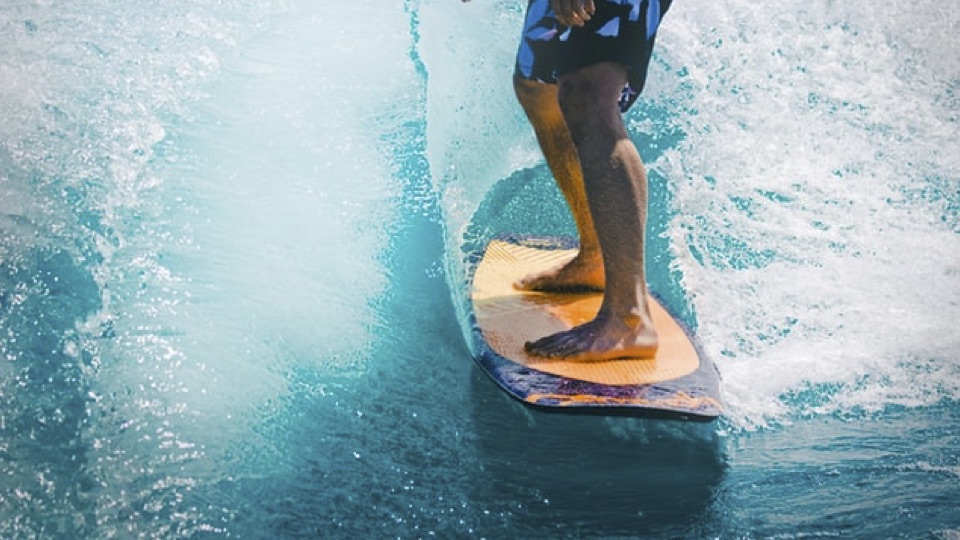Standing on one foot is not only good for your arches, ankles, and calves, it’s very good medicine for your mind. Especially as you age. One in four Americans over the age of 65 takes a fall each year, reports the CDC. 3 million of us actually wind up in the ER because we lose our balance and fall. Sadly, 95% of all hip fractures are caused by falling, usually falling sideways.
Why do we fall? There are problems with muscular coordination, poor core strength, and poor attention to one’s surroundings.
Related: “3 Good Reasons to Work Your Core (and How To Do It)
There’s no doubt that being younger and in better overall shape helps keep us upright most of the time. But it’s not just your muscles and joints that keep you upright, it’s your proprioceptive powers. Which is to say, your sense of where you are in space as you stand, sit, and move.
Practicing balance improves those proprioceptive powers that you need to prevent injury when and if you fall. Researchers at the National Institutes of Health tell us, a practice of balancing (tai chi, yoga, or just no hands, standing on one foot, ) causes actual changes in two regions of the brain responsible for memory and spatial cognition. These are the parts of the brain that deal with the formation of long-term memories, and that is the first to be damaged by Alzheimer’s.
So how do we keep our balance anyway? It’s complicated. There’s the inner ear, which senses your head movements, your somatosensory system, (that gives you the feeling of the ground beneath your feet), plus your field of vision which alerts you to obstacles below above and around you. Professional dancers and circus performers, for example, have advanced skills in spatial awareness. For the rest of us, drills aimed at making us proprioceptive pros are what save the not-falling day.
OK, you don’t have to become Baloo the Bear balancing on one toe. But even simple stabilization challenges promote greater “neuroplasticity,” which in turn keeps the brain supple and young, enhancing memory and other brain functions like reading, comprehension, and mathematics. Challenges to your coordination, agility, and balance, appear to rewire your brain in a way that is different from that of aerobic or strength training. Subjects in one study who had difficulty standing on one leg were shown to have lower cognitive functions of memory and spatial awareness. The high levels of inner concentration required in yoga balance postures, for example, make them among the best exercises because they challenge a number of internal systems simultaneously. The deep inner focus required to stay upright causes actual changes in the brain.
So maybe you don’t need more cardio and crosswords: maybe you need to make like a stork and spend more time hanging out on one leg.
Here are some ways to do just that. Note that novelty and unpredictability are what prompt the brain to build new neural connections and pathways. So perhaps try balancing on an unstable surface like the lawn or the beach occasionally. And mix it up. Don’t do the exact same balance position every time. Maybe a tai chi move or two indoors on Monday? Balancing outdoors on Wednesdays, and maybe a yoga pose or two on Friday? And remember that just standing on one leg while you brush your teeth can get the balancing day off to a good start. Repetition helps your basic balance abilities, but novelty improves your important neuroplasticity prowess.
Here are some simple brain-proofing, fall-preventing practices to fit into your everyday life. These are all done best in bare feet which allow you to get the full natural support of your foot. And make sure the floor is clear of obstacles and there is a counter or piece of furniture nearby if you need to grab it.
- Stork: Standing on one leg, Spread the toes. Pull the other leg up toward the waist and hold under or around the bent knee. Good posture and a nice aligned spine. Breathe normally and fix your gaze on a stationary object. How long can you stand without tipping?
- Stork Variation: Do the above with arms extended overhead or bend the knee behind the back and grab hold of the ankle or toes and hold. You get the bonus of a nice thigh stretch.
- The Tree: three ways: From a standing position, hands at waist. Extend one leg forward a few inches off the floor and hold. Try not to lean to the opposite side. Start with one hand on a counter or chair if you need it. As you improve, try lifting the leg higher without leaning to the opposite side. Do the above with the leg extended behind you. Finally, try bending the knee opening it to the side, and placing the toes at the ankle. Bring the palms together in front of the chest. For more challenge, try closing your eyes.
- Tightrope walk. Standing tall, arms in a T, walk forward placing your heel directly in front of the toe of the other foot, and continue forward a few steps. Then walk backward placing the toe of the front foot behind the heel of the back foot.
Note: backward is harder than forwards. Perfect that first. Make sure the floor beneath and around you is clear of obstacles and there is something to grab hold of if you need it.
- Standing Figure Four: Start in a standing position, then bend both knees as though you were about to sit in a chair, bringing one leg up and cross the ankle over the opposite knee. Hold for 3o seconds or so with hands at the chest or on the hips or extended overhead. Then switch legs.
-Frances Goulart
Photo by Joseph Greve on Unsplash




Frances, I enjoyed going through all the poses. Thanks for inspiring me to better health!